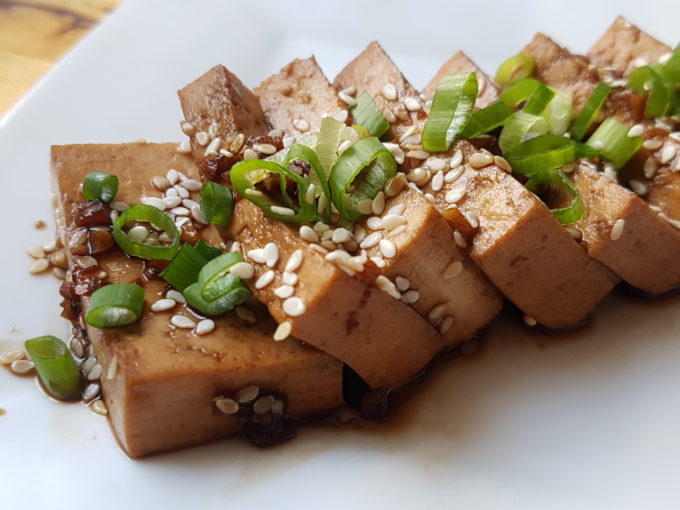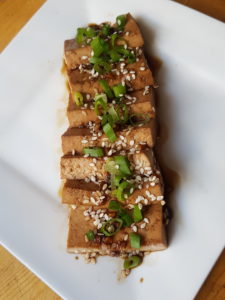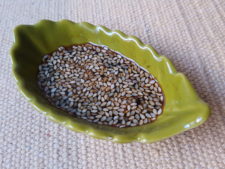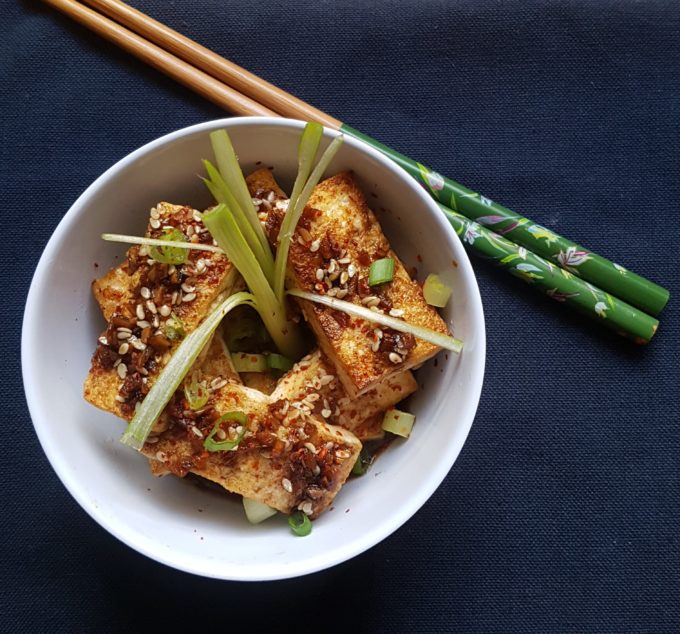 Over the last couple of years I have really expanded the line of products I purchase from The New Central Market here in Anchorage. Given, they have expanded, too. The one thing I don’t usually go for, and probably because I simply like to cook myself, are their pre-made dishes. The owner, Somya, is always bragging that they make their own kimchi daily, and has also taken me aside to show off the beautiful meat display, which they also prep right on site, but I’ve really never tried their cooked dishes.
Over the last couple of years I have really expanded the line of products I purchase from The New Central Market here in Anchorage. Given, they have expanded, too. The one thing I don’t usually go for, and probably because I simply like to cook myself, are their pre-made dishes. The owner, Somya, is always bragging that they make their own kimchi daily, and has also taken me aside to show off the beautiful meat display, which they also prep right on site, but I’ve really never tried their cooked dishes.
One day, while I was checking out, a young lady was waiting a few extra minutes for a fresh made tofu plate. Somya of course takes the chance to brag on their hand made options, “Oh dis is good one! You need try it!” and the girl concurred. I took a look and asked if it was spicy. (It looked spicy. Everything in Korea is spicy.) But she said this wasn’t. Intrigued I wrote down the name on the label with plans to research it back home: BANCHAN
Right now, anyone who knows even a little bit about Korean cuisine, is probably laughing at me. ‘Banchan’ in Korean means “food/rice + sidedish”. Banchan (also written panch’an) are the side dishes that are served as part of the traditional table setting for bansang (반상); a meal setting for one person. Along with a large bowl of rice there is served a clear soup, a cloudy or stew-like soup, condiments like gochujang, and kimchi, and the inclusion of either 3, 5, 7, 9, or (if you are royal) 12 banchan. Everything is served at once and set with vary particular placing. It’s really quite fascinating, and worth more than the few words I gave it here. You can check-out this link with many beautiful photographs and a great explanation if you are interested to learn more.
 So, now that we all know this, it is easy to see why I chuckled at myself for trying to look up the recipe for ‘Banchan.’ It’s like looking up ‘sidedish’ and expecting the search page to be filled with recipes specifically for grilled mushrooms. You might also compare it to the Spanish word ‘tapas,’ or ‘meze’ in Middle Eastern countries. Lucky for me I knew it was ‘tofu’, ‘not spicy’, and looked like it had green onions so I was able to narrow it down quite easily. But still. I laughed at my ignorance.
So, now that we all know this, it is easy to see why I chuckled at myself for trying to look up the recipe for ‘Banchan.’ It’s like looking up ‘sidedish’ and expecting the search page to be filled with recipes specifically for grilled mushrooms. You might also compare it to the Spanish word ‘tapas,’ or ‘meze’ in Middle Eastern countries. Lucky for me I knew it was ‘tofu’, ‘not spicy’, and looked like it had green onions so I was able to narrow it down quite easily. But still. I laughed at my ignorance.
There are two ways to go about this recipe. You can either pan fry the tofu first and top it with ‘the sauce,’ (which I can NOT find a name for anywhere!) or you can braise the tofu in the sauce which specifically makes it dubu jorim (tofu+simmered dish).
And speaking of sauce, in my search I found there to be as many ways to make the braising sauce as there were recipes. I put this one together to be just the right amount of sweet, but also tangy, and of-course salty. I, personally, didn’t want sesame oil to take over the sauce, but marked it as an option for those of you who might really like the addition.
 All together this is really quite a great recipe because it doesn’t require very many ingredients and is SUPER quick to throw together.
All together this is really quite a great recipe because it doesn’t require very many ingredients and is SUPER quick to throw together.
- I like this simple sauce so much that I make an extra batch of it to have on hand for steamed vegetables, rice or noodles, or for adding to soups. A little can go a long way so it holds it’s place in the fridge well.
- Since it is sweet and there is no spice (unless you choose to add it) it is also a great way to introduce children to both Tofu and Korean food.
- It is also perfect to take for your lunch because it holds firm and can easily be eaten cold. In fact it is a common component for dosirak; the Korea lunch box.

This is the fried rendition, with the sauce simply poured over. I also added a little gochugaru (Korean red pepper flakes). I have to say that the flavor and slight crisp of the fried tofu is quite inviting.
Be sure to leave me a comment below letting me know how you cooked it, and if you decided to eat it as a snack or serve it as one of the banchan in a meal.
Dubu Jorim – Braised Tofu Banchan
By:semiserious chefs
Serves:4-6
Ingredients:
- One block of firm or extra firm tofu
- 1/4 cup soy sauce
- 2 t sugar
- 1 t fine minced garlic (1 large clove)
- 1 t rice vinegar
- 2 t sesame seeds (plus some for garnish)
- optional: 1/8 t sesame oil
- optional: red pepper flakes (gochugaru) to taste
- 2 green onions; sliced or julienne
Directions:
- Use a knife to cut the tofu, right in the tray, into an even grid of either 6×5 or 6×6; 30-36 pieces.
- Add the soy sauce, sugar, minced garlic, vinegar, and sesame, (plus sesame oil if using), to a medium skillet. Bring to a simmer over medium-low heat. You don’t want to boil your sauce or the sugar will start to caramelize.
- Add the sliced tofu to the sauce and let it braise for 1 minute on each side. Remove and plate. This can, and probably should, be with white rice.
- When all the pieces have been braised and plated pour the remaining sauce equally over each dish. (You can make a second batch of sauce, gently warmed in a pan to incorporate the sugar and aromatize the garlic, as needed.)
- Add a generous helping of green onions and extra sesame seeds atop (and gochugaru as desired). Serve!


Post a comment